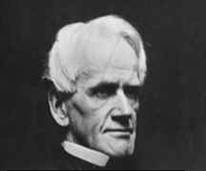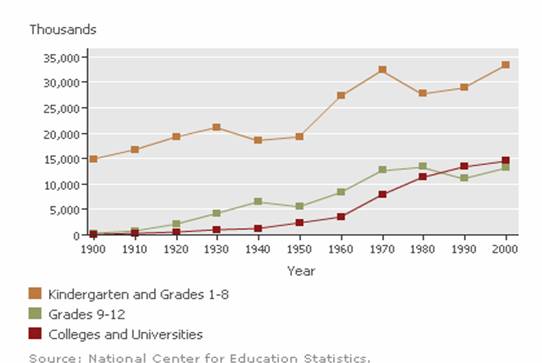Public Education in the United States
1 INTRODUCTION
Public Education in the United States , programs of instruction offered to children, adolescents, and adults in the United States through schools and colleges operated by state and local governments. Unlike the nationally regulated and financed education systems of many other industrialized societies, American public education is primarily the responsibility of the states and individual school districts.
The national system of formal education in the United States developed in the 19th century. It differed from education systems of other Western societies in three fundamental respects. First, Americans were more inclined to regard education as a solution to various social problems. Second, because they had this confidence in the power of education, Americans provided more years of schooling for a larger percentage of the population than other countries. Third, educational institutions were primarily governed by local authorities rather than by federal ones.
The most notable characteristic of the American education system is the large number of people it serves. In 2002, 86 percent of Americans between age 25 and 29 had graduated from high school, 58 percent had completed at least some college, and 29 percent had earned at least a bachelor's degree. Expanding access to college education is an important priority for the U.S. government.
2. ELEMENTARY EDUCATION AND THE COMMON-SCHOOL MOVEMENT
 A Massachusetts lawyer and legislator, Horace Mann became the secretary of the nation's first state board of education in 1837. Mann worked to establish nonreligious public schools to provide common education for all citizens, which he argued is essential to democracy. “The scientific or literary well-being of a community,” wrote Mann, “is to be estimated not so much by possessing a few men of great knowledge, as its having many men of competent knowledge.”
A Massachusetts lawyer and legislator, Horace Mann became the secretary of the nation's first state board of education in 1837. Mann worked to establish nonreligious public schools to provide common education for all citizens, which he argued is essential to democracy. “The scientific or literary well-being of a community,” wrote Mann, “is to be estimated not so much by possessing a few men of great knowledge, as its having many men of competent knowledge.”
The common-school reformers optimistically argued that education could transform all youth into virtuous, literate citizens. They suggested that education could build a distinctive new nation that would be better equipped to compete with other countries. They appealed to people's fears about growing economic and religious tensions in the United States as immigration of various ethnic groups increased. The reformers believed that common schooling could create common bonds among an increasingly diverse population. It could also preserve social stability and prevent crime and poverty. Common-school advocates contended that free elementary education should be available to everyone, that it should be financed by public funds, and that it should be conducted in schools accountable not only to local school boards but to state governments. They also argued for the establishment of compulsory school attendance laws for children of elementary school age.
3. SECONDARY SCHOOLS
Before the 20th century, a bewildering variety of schools existed for the small number of teenagers who had the ability or the desire to pursue education beyond the elementary level. These schools offered students opportunities to prepare for college, or to learn a complex skill instead of competing for one of the rapidly decreasing number of on-the-job apprenticeships. Only a relatively small number of teenagers had the ability or desire to pursue secondary education. In 1900 only 10 percent of American adolescents aged 14 to 17 were enrolled in high schools. Most of these students were from affluent families.
The first publicly supported secondary school in the United States was Boston Latin School , founded in 1635. But until the late 19th century secondary education was mostly conducted by private tutors or privately supported academies. Public financing for secondary education was rare until 1874, when a Michigan Supreme Court decision involving the city of Kalamazoo established that communities could use local property taxes to support high schools.
The rise in American high school attendance was one of the most striking developments in U.S. education during the 20th century. From 1900 to 2000 the percentage of teenagers who graduated from high school increased from about 6 percent to about 88 percent. High school attendance grew because more and more students regarded additional schooling as the key to succeeding in an increasingly urban and industrialized society. In addition, after the introduction of strict child labor laws in the early 20th century, fewer teenagers entered the workforce than they had previously, which gave them the time to attend school. School provided teenagers with an acceptable alternative to labor that gave meaning to their lives before they entered the workforce, established a family, or began college. As the 20th century progressed, most states enacted legislation extending compulsory education laws to the age of 16. Most students found it more enjoyable—and more profitable in the long run—to stay in school beyond the legal limits than to leave, or drop out, before graduating.
The 20th century high school was a uniquely American invention. More than elementary schools or colleges, high schools demonstrated the American faith that schooling could successfully address a lengthening list of individual and social concerns. High schools provided supervision and a place for youth to experience adolescence with friends. They also sought to give students education to meet the practical demands of everyday life, to get a job, or to go on to more education. By “Americanizing” immigrants into mainstream political and social values, public high schools worked to accomplish for adolescents what the common elementary school had always attempted for younger students. High schools thus embodied the sometimes contradictory values of educating students to fit into American society while providing opportunities for them to break out from whatever social or economic circumstances constrained their development.
4. HIGHER EDUCATION
During the 20th century participation in higher or postsecondary education in the United States increased as dramatically as it did in American high schools. At the beginning of the century about 2 percent of Americans from the ages of 18 to 24 were enrolled in a college. There were fewer than 1,000 colleges then, with enrollment totaling about 157,000 students. Near the end of the century more than 60 percent of this age group, or over 14 million students, were enrolled in about 3,500 four-year and two-year colleges. This tremendous increase did not even include the 6,500 postsecondary vocational and technical institutes that enrolled millions of additional students but did not give bachelor's or associate degrees.

Microsoft Encarta 2006. 1993-2005 Microsoft Corporation.
U.S. Enrollment Levels
School enrollments rose steadily from 1890 to 1970 with a downturn in elementary education during the 1940s. More recently, though high school enrollments decreased in the 1980s, the number of students enrolled in college has steadily increased.